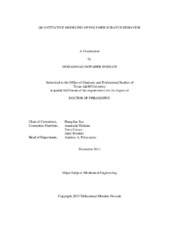| dc.contributor.advisor | Sue, Hung-Jue | |
| dc.creator | Hossain, Mohammad Motaher | |
| dc.date.accessioned | 2014-05-13T17:22:59Z | |
| dc.date.available | 2014-05-13T17:22:59Z | |
| dc.date.created | 2013-12 | |
| dc.date.issued | 2013-12-02 | |
| dc.date.submitted | December 2013 | |
| dc.identifier.uri | https://hdl.handle.net/1969.1/151771 | |
| dc.description.abstract | Scratch-induced surface deformation is a complex mechanical process due to high strain rate large-scale deformation, non-linear material response, heat dissipation and complex stress field evolved during the process. The rate, time, temperature and pressure dependent behavior of polymers, and the surface condition of the interacting surfaces also add to the complexity. In order to gain in-depth understanding of polymer scratch behavior; this dissertation focuses on numerical analysis and experimental study of scratch-induced deformation in polymers, leading to quantitative prediction of scratch behavior of model amorphous polymers.
A comprehensive three-dimensional finite element method (FEM) parametric study has been performed by incorporating key characteristics of polymer constitutive behavior to investigate the effect of material parameters and surface properties on the evolution of scratch-induced deformation in polymers, along with relevant experimentation. The qualitative analyses using FEM simulation and experimental work suggest that indeed correlation between material and surface properties, and scratch-induced damage mechanisms can be established.
To quantitatively predict the scratch behavior of polymers via FEM, PC and SAN model systems are chosen. A modification of Ree-Eyring theory is used to assess the rate dependent behavior of model polymers at high strain rates based on the experimental data obtained at low strain rates. By including the rate and pressure dependent mechanical behavior and pressure dependent frictional behavior in the FEM model, good agreement has been found between FEM simulation and experimental observations. The results suggest that, by including proper constitutive relationship and friction model in the numerical analysis, the scratch behavior of polymers can be quantitatively predicted with reasonable success. | en |
| dc.format.mimetype | application/pdf | |
| dc.language.iso | en | |
| dc.subject | Polymer scratch | en |
| dc.subject | scratch damage | en |
| dc.subject | finite element method | en |
| dc.subject | quantitative prediction | en |
| dc.subject | constitutive relations | en |
| dc.subject | scratch-induced deformation | en |
| dc.title | Quantitative Modeling of Polymer Scratch Behavior | en |
| dc.type | Thesis | en |
| thesis.degree.department | Mechanical Engineering | en |
| thesis.degree.discipline | Mechanical Engineering | en |
| thesis.degree.grantor | Texas A & M University | en |
| thesis.degree.name | Doctor of Philosophy | en |
| thesis.degree.level | Doctoral | en |
| dc.contributor.committeeMember | Muliana, Anastasia | |
| dc.contributor.committeeMember | Creasy, Terry | |
| dc.contributor.committeeMember | Bluemel, Janet | |
| dc.type.material | text | en |
| dc.date.updated | 2014-05-13T17:22:59Z | |


